Utah County Birders Newsletter
|
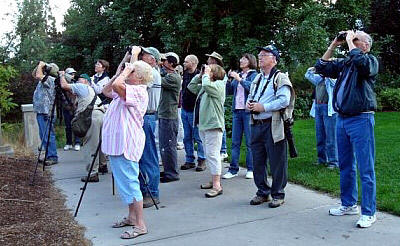 |
|
UOS Conference Participants Birding on BYU Campus - 8
Sep 07 |
Thoughts on the recent UOS Conference
I would like to thank the following individuals for
leading fieldtrips to the following parts of the county during the recent Utah
Ornithological Society's conference hosted by our birding club: Dennis Shirley
to the south part of Utah County, Eric Huish to the Alpine Loop area and also
around the BYU campus with Milton Moody, and Lu Giddings for his trip to the
south part of Utah County and the north part of Juab County. During five
fieldtrips a combined total of 114 species of birds were observed. Some of
the "best" ones were Ruffed Grouse, Black-bellied Plover, Williamson's
Sapsucker, White-breasted Nuthatch and Townsend's Warbler.
Thanks also to Larry Draper for helping with the
Saturday morning set-up and to Tuula Rose for helping with the Friday evening
registration.
The scientific presentations Saturday at the Bean
Museum were varied, interesting and well-presented including UCB member Landon
Jones' research on the importance of calcium in pheasants. I had assured
the UOS leadership that members of our group would be supportive of the
conference by leading fieldtrips, helping with registration and that we would be
well-represented at the presentations. The latter prediction turned out to
be false. Those of you who elected to not attend any of the presentations
or fieldtrips missed out. But then, why should I just be critical of our
members. Only one of the voting members of the Utah Birds Record
Committee, that august assemblage of committed birders who represent the UOS in
accepting rare birds, was in attendance. Oh, I forgot, they were out
looking for rare birds for the rest of us to chase.
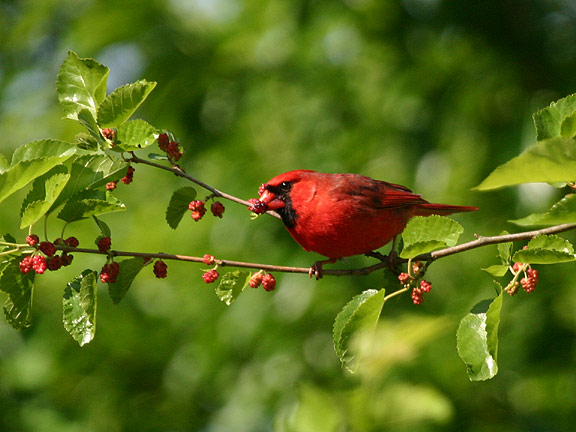 |
|
photo by Tim Avery |
Bird of the
Month
Northern Cardinal
Cardinalis cardinalis
by Ned Bixler
The Northern Cardinal is a bird whose range has expanded northward in the last
100 years. It was originally a bird of the Southeast. In 1886, this bird was
found only occasionally north of the Ohio River. By 1895, it had reached the
Great Lakes, and by 1910, it was found in Ontario. Since the 1950s, expansion to
the northeast has increased; whereas dispersal to the northwest has slowed. The
cardinal is limited in the West to areas where the annual precipitation is at
least 16 inches. Therefore, centers of abundance for this bird are along the
Mississippi River, and along the Colorado and Guadalupe River in Texas. They
have been reported in New Mexico, Arizona, and a few in California. Close to
Utah !
In the 1800s, the cardinals were much-sought-after cage birds. They were highly
valued for their color and song. Thousands were trapped in the south in the
winter, and sent to northern markets. Thousands more were sent to Europe. This
trade ceased with passage of the Migratory Bird Treaty Act of 1918.
More states have adopted the Northern Cardinal as their state bird than any
other bird. These states are: Illinois, Indiana, Kentucky, North Carolina, Ohio,
Virginia, and West Virginia.
The cardinal is a medium-sized songbird (approximately 8.75 inches in length).
It has a short, rounded wing, and a long tail. It has a conical bill, and a
crest. The males are nearly all brilliant red, with a brownish gray-tinged
scapular. The coral red bill is surrounded by a mask of black that extends to a
dark eye. The legs are dark red. The females are a soft grayish brown on the
back with variable areas of red on the tail, crest, and wings. The coral red
bill is surrounded by darker, but not black, feathers, so her mask is not as
distinct as the male's. Females are slightly smaller than males. Juveniles are
more like females.
Cardinals are noted for their loud, clear whistled songs. Females will counter
sing, duetting with males, usually after the males have established territories
and before nesting begins. Their song is a loud, liquid whistling with many
variations. A common call is a sharp chip. Both sexes sing year around.
Cardinals mate for life. They prefer a dense area, such as a thicket or thickly
branched tree to make their nest of twigs and grass. The female will lay 3-5
eggs and incubate them. The male will provide the food for them. When it is time
to fly, the male will watch over them, so the female may begin a second brood.
The bill of the cardinal is adapted to eating seeds of all sorts. It also has a
varied diet of fruit, seed, and insects. They are a non-migratory bird.
One-third of its summer diet can be insects, and the winter diet is
approximately 90 percent vegetable matter. Winter flocks can be very large, up
to 60 individuals in an area.
Several birds that are similar to the cardinal are: the Hepatic tanager, Summer
tanager, and the Pyrrhuloxia.
The Summer tanager is found in Southern Utah.
Provo once had the good fortune to have several cardinals living in the city
(illegally). As their territory changes, Utah may, some day, become home to
these beautiful birds !! My wishes are that every birder has the chance to see
this bird in a snow covered tree, as there is not a more beautiful scene in
birding.
UOS Conference Field Trip Reports
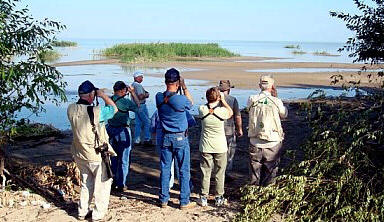 |
|
South Utah County - Sandy Beach - 7
Sep 2007 |
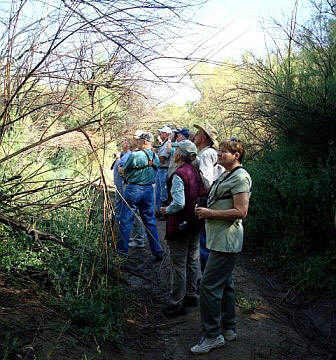 |
|
South Utah County - River Lane - 7 Sep
2007 |
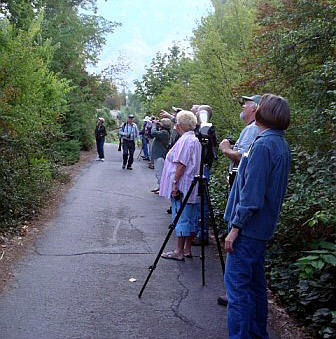 |
|
BYU Campus - 8 Sep 2007 |
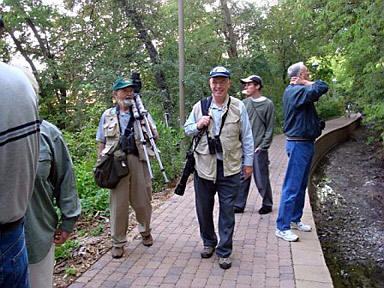 |
|
BYU Campus - 8 Sep 2007 |
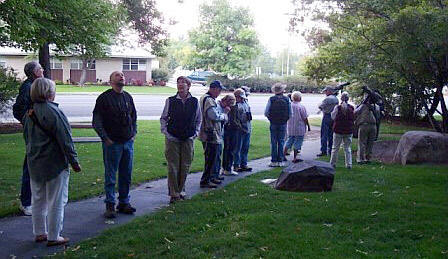 |
|
BYU Botany Pond - 8 Sep 2007 |
There were many great Field Trips led by Utah County Birders during the Utah
Ornithological Society Conference.
South Utah County - Friday Sept. 7th
Lead by Dennis Shirley
We don’t have a Field Trip report but I heard they had a great time and had a
large species list. They started at 8:00 a.m. and were back in time for the 1:00
p.m. Field Trip. Leena took some photos.
Diamond Fork Canyon - Friday Sept. 7th
Lead by Merrill Webb - Trip Report by Eric Huish
We left at 1:00 p.m. Our first stop was at the small pond as you turn off Hwy 6.
In this area we got some dabbling ducks and Killdeer in what was left of the
pond. There was also American and Lesser Goldfinch, Violet-green Swallows, a
Steller’s Jay and a Golden Eagle here.
We made a few stops as we made our way up the canyon to the campgrounds and were
able to see a Sharp-shinned Hawk, 4 Am Kestrels, Black-capped Chickadees, more
VG Swallows, 2 Ravens, a Say’s Phoebe, a Belted Kingfisher and we heard a Gray
Catbird.
The Campgrounds were full of berry filled bushes which were full of Robins.
Other birds at the campgrounds included - Townsend’s Solitaire, Cedar Waxwings,
Spotted Towhee, Red-naped Sapsucker, Song Sparrow, Blue-grey Gnatcatcher, Am Dipper
and we got a look at a Gray Catbird.
Near the end of the trip Merrill took us to a beautiful Redrock outcropping
where we were able to see more Steller’s Jays, a White-breasted Nuthatch and
heard a Canyon Wren Singing.
It was a great trip. Diamond Fork is a beautiful canyon that I will now be sure
to go and bird in the future.
Botany Pond, BYU Campus - Saturday Sept. 8th
Lead by Milton Moody - Trip report by Eric Huish
This bird walk was from 7:00 a.m. to 8:30 a.m. T he paper & presentations
portion of the UOS conference was to start at 9:00 a.m. Unfortunately just as
the sun was about to rise above the mountain we ran out of time. We did get a
few good birds. There were many Western Tanagers, a few MacGillivray’s Warblers
we could often hear but seldom saw, a Red-napped Sapsucker and other common
birds. Milt also pointed out and identified the interesting trees that have been
planted on campus.
Alpine Loop - Sunday Sept. 9th
Lead by Eric Huish - Trip Report by Eric Huish
We spent most of this half day trip in the Aspen Grove area where we got some nice
mountain birds. Steller’s Jays, Mt Chickadees, Golden-crowned Kinglets, Western
Tanager, Downy Woodpecker, Red-breasted Nuthatch, White-throated Swift, Dark-eyed Junco, Pine Siskin, Plumbeous Vireo and more. By far the best bird of the day was a Ruffed Grouse
that gave us great, very close views. We also saw an Osprey on our way up the
canyon and stopped to get a Dipper on our way out.
Tintic Mountains - Sunday Sept. 9th
Lead by Lu Giddings - Trip Report by Lu Giddings
Seven of us left the Provo Shopko parking lot shortly after 7 a.m.
We passed through Santaquin and up the road nearly to Eureka, birded down the
Dividend road, went up into the mountains past Burgen and across the spine of
the East Tintic range via Silver City Pass, across Tintic Valley, and spent the
afternoon birding various migrant traps along Cherry Creek, which runs down the
west slope of the West Tintic mountains. The weather was warm and beautiful and
the birding was surprisingly good. While no Code 5 birds were seen, there were a
number of highlights which include, in no particular order:
- the beautiful lush wet areas of Cherry Creek in the middle of the
pinion-juniper desert are marvelous. A number of species not normally seen in
the desert were observed, including three duck species, a spectacular,
show-boating belted kingfisher, American coots, and a Wilson's snipe. A
remarkable number of flowers and flowering plants were also in bloom.
- four Empid species, five warbler species, and eight sparrow species were also
observed.
- the world's most placid Williamson's sapsucker hammered away on a cottonwood
tree for over an hour, completely unconcerned with seven curious birders milling
about merely a few feet beneath it. The tree must have xanax running in its sap.
- a field filled with mountain bluebirds and yellow-rumped warblers, with a few
Brewers sparrows and house finches thrown in, dining on rabbit brush (or bugs on
the rabbit brush) in the East Tintics.
- another second field of blooming rabbit brush, this one filled with house
finches, American goldfinches, a variety of sparrows, and a painted bunting we
were sure was there but which we never did quite see.
- a very cooperative sharp-shinned hawk, which posed briefly for us after
scaring away all the little birds on the Dividend road.
- trees filled with a variety of migrants at Dividend flats.
- a three falcon day is always a good one.
- four golden eagles were seen during the trip, and four more were seen while
driving toward home across Little Dog Valley, including one, dining on
road-kill, from about 25 yards.
Other beasties spotted included deer, badgers, and a green-breasted short-eared
owl-squirrel (don't ask). We also won't tell you who nearly went skinny-dipping
in the reservoir at the end of the day.
Participants (please forgive any spelling errors): Paulette Howard, Sandy
Castlebury, Susan Saffle, Kathy Roach, Kathy Robins, Hal Robins.
Thanks for the support and for a great day!
Total Count: 66 species
UOS Conference List
Following is the list of birds seen on the 5 UOS field trips Friday - Sunday, Sept. 7-9. Compiled by Steve Carr
American Wigeon, Mallard, Cinnamon Teal, Green-winged Teal, Northern Pintail,
Ring-necked Pheasant, Ruffed Grouse, Pied-billed Grebe, Western Grebe, Clark's
Grebe, Am. White Pelican, Double-crested Cormorant, Great Blue Heron, Snowy
Egret, White-faced Ibis, Turkey Vulture, Osprey, Northern Harrier, Sharp-shinned
Hawk, Red-tailed Hawk, Golden Eagle, American Kestrel, Peregrine Falcon, Prairie
Falcon, American Coot, Sandhill Crane, Killdeer, Black-bellied Plover,
Black-necked Stilt, American Avocet, Greater Yellowlegs, Solitary Sandpiper,
Spotted Sandpiper, Western Sandpiper, Least Sandpiper, Calif. Gull, Caspian
Tern, Rock Pigeon, Eurasian Collared-Dove, Mourning Dove, Common Nighthawk,
White-throated Swift, Black-chinned Hummingbird, Rufous Hummingbird, Belted
Kingfisher, Williamson's Sapsucker, Red-naped Sapsucker, Downy Woodpecker,
Northern Flicker, Olive-sided Flycatcher, Western Wood-Pewee, Hammond's
Flycatcher, Gray Flycatcher, Say's Phoebe, Western Kingbird, Plumbeous Vireo,
Cassin's Vireo, Warbling Vireo, Steller's Jay, West. Scrub-Jay, Pinyon Jay,
Black-billed Magpie, Common Raven, Horned Lark, Tree Swallow, Violet-green
Swallow, Rough-winged Swallow, Bank Swallow, Barn Swallow, Black-capped
Chickadee, Mountain Chickadee, Red-breasted Nuthatch, White-breasted Nuthatch,
Rock Wren, Canyon Wren, Bewick's Wren, American Dipper, Golden-crowned Kinglet,
Ruby-crowned Kinglet, Blue-gray Gnatcatcher, Mountain Bluebird, Townsend's
Solitaire, American Robin, Eur. Starling, Cedar Waxwing, Orange-crowned Warbler,
Nashville Warbler, Virginia's Warbler, Yellow Warbler, Yellow-rumped Warbler,
Townsend's Warbler, Wilson's Warbler, MacGillivray's Warbler, Western Tanager,
Green-tailed Towhee, Spotted Towhee, Chipping Sparrow, Brewer's Sparrow, Vesper
Sparrow, Lark Sparrow, Song Sparrow, White-crowned Sparrow, Dark-eyed Junco,
Red-winged Blackbird, Western Meadowlark, Yellow-headed Blackbird, Brewer's
Blackbird, Great-tailed Grackle, House Finch, Pine Siskin, Lesser Goldfinch,
American Goldfinch, House Sparrow.
- Total 114.
Backyard Bird of the
Month
September 2007
Steve Carr - Holladay
White-crowned Sparrow - Several appearances during the last half of the
month.
Alona Huffaker - Springville
The few Evening Grosbeaks that have been visiting off and on since the
last week or so of August. They are very sporadic visitors and leave quickly, so
quickly, that Bonnie next door hasn't even made it to the window to see them
high up in a dead tree in my back yard before they are on their way again. Once
in awhile I will spot them on my feeders, too.
Eric Huish - Pleasant Grove
Lesser Goldfinch - I am very happy to have many, all month, every month.
Milt Moody - Provo
White-crowned Sparrows - giving hope for a White-throated or better.
Reed Stone - Provo
White-breasted Nuthatch - "grazing" up and down, round and round my old
dead tree.
Alton Thygerson - Provo
Red-breasted Nuthatch - first one I've ever seen in my backyard.
Bonnie Williams - Mapleton
Evening Grosbeak - finally I got a glimpse of them in my tree.
We would like you to share your favorite backyard bird each
month. Please send your favorite bird at the end of the month to
newsletter@utahbirds.org or call 360-8777. If you would like a reminder at
the end of the month e-mail the above address.